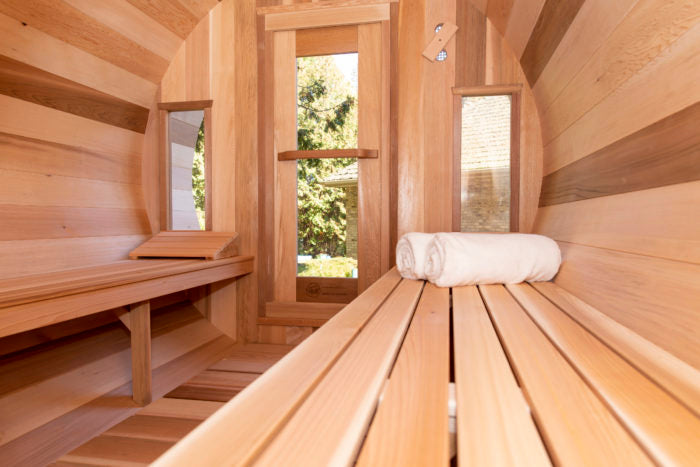5 Simple Techniques For Traditional Sauna
5 Simple Techniques For Traditional Sauna
Blog Article
The 6-Minute Rule for Traditional Sauna
Table of ContentsThe Greatest Guide To Traditional Sauna6 Simple Techniques For Traditional SaunaThe Basic Principles Of Traditional Sauna The Facts About Traditional Sauna RevealedThe 5-Minute Rule for Traditional Sauna
Most of the weight lost in a sauna is water loss and is re-gained upon rehydrating. Without a doubt sauna can be a crucial component of a healthy weight loss program. To take a look at the distinctions in between typical and IR saunas, I will certainly separate these into verifiable, academic, and produced distinctions.Thus, the most popular factor in the saunawhich is at the ceiling directly above the sauna heateris typically between 185 and 190 F. Claims that a traditional sauna goes beyond 200 F is simply not true and not relevant for electrical saunas sold in the United States. The temperature for a far-infrared sauna is normally set in between 120 and 140 F; nonetheless, unlike the traditional sauna, the goal in and IR room is not to attain a heat.

When a typical sauna has been appropriately warmed, the sauna walls are cozy, the air temperature level has actually achieved established temperature and the rocks are super heated. As an interesting side note, the warmed walls and the rocks are sending out far-infrared warm, integrated with the heated air, to create an "enveloping heat".
About Traditional Sauna
When the high temperature is accomplished, the elements cycle on and off to keep the high temperature level. Most typical sauna customers enjoy pouring water over the rocks to produce vapor to increase sauna moisture levels. The benefits of pouring water over the rocks consist of: making the area more comfy, moistening the nasal flows, and permitting the usage of aromatherapy by blending important oils with the water.

When the power gets in the body, it creates the body temperature level to boost and eventually leads to sweat. In an infrared sauna it is necessary for the emitters/heaters to continue to be on virtually frequently. Since there is no mass of rocks to preserve warm, the sauna will cool down if the emitters shut down.
Traditional Sauna Fundamentals Explained
As mentioned over, the sauna bather in an infrared room desires to place himself in front of operating emitters to get maximum gain from the special info heat. The heating time for both areas can be very different, depending on exactly how the areas are utilized. For a conventional sauna, a bather must enable 30-40 minutes for the area to attain a desired temperature and to appropriately pre-heat the rocks.

A well built sauna will typically attain a temperature level of 150-160 F in about 30-40 minutes (Traditional Sauna). For hotter temperatures, the room may need to heat for a longer period. When the area attains established temperature, the heater will certainly cycle on and off, normally operating about 50% of the moment. The shielded wall surfaces and the heated rocks will keep the area warm and at steady temperature levels.
To some, 15 mins was "wasted" while the infrared power heated up the timber panels rather than warming a body, while others find a pre-heated space to be extra comfortable and believe an elevated starting temperature level is necessary to start sweating. The size of advised use for each space is approximately the very same (10-15 mins per session); however, as a result of the lower air temperature levels and the capacity to really feel the results of infrared heat much faster than a conventional sauna, it is not unusual for an individual to invest a total amount of 20-30 minutes in an infrared sauna.
Facts About Traditional Sauna Uncovered

The typical expense per kWH of electrical energy in the U.S. is roughly $0.11, see this site so a 4.5 kW heating unit will certainly cost around $.50 to compete one hour, if the heating unit runs continually for one hour. Typically a sauna heating unit will certainly compete 75% of the initial hour and 50% of subsequent hours on since the aspects cycle once the set temperature is accomplished.
A 2 person far-infrared room is usually literally smaller sized than a traditional sauna, typically regarding 4' x 4' or smaller. The IR heater is generally 1.5-1.7 kW making use of a 120 volt Going Here 15 amp plug-in solution. Since the room can be made use of faster than a sauna area, we will presume the room is used for to of an hour consisting of warm up time.
There is a seldom reviewed difference in the social experience between the two rooms. While our culture has lost a few of the social advantage of the typical sauna experience, it can be very socially rewarding (Traditional Sauna). From household time in the sauna, to heart-felt conversations with substantial others, to sauna partiesthe standard sauna experience can cause intimate socializing
Rumored Buzz on Traditional Sauna
Most greater end infrared spaces consist of tinted light therapy, noise systems and full-glass fronts.
Report this page